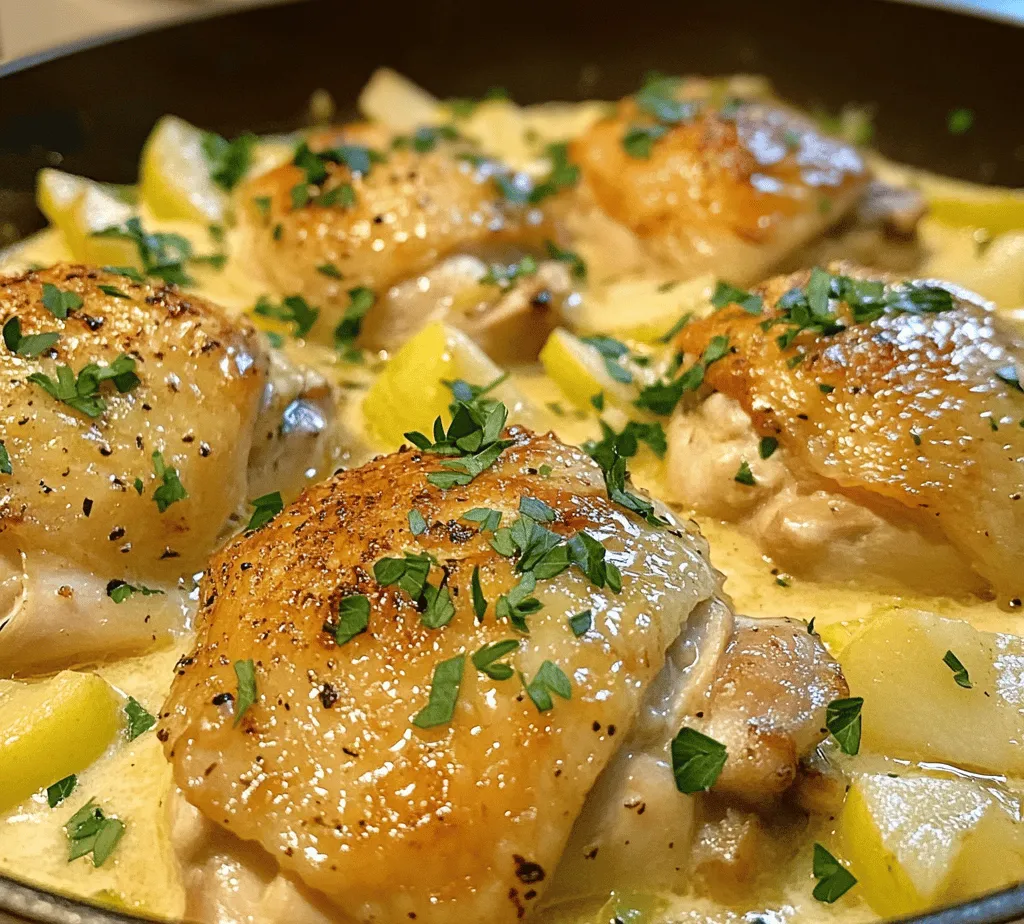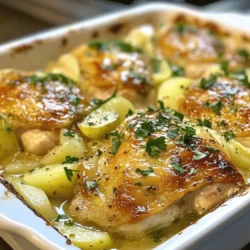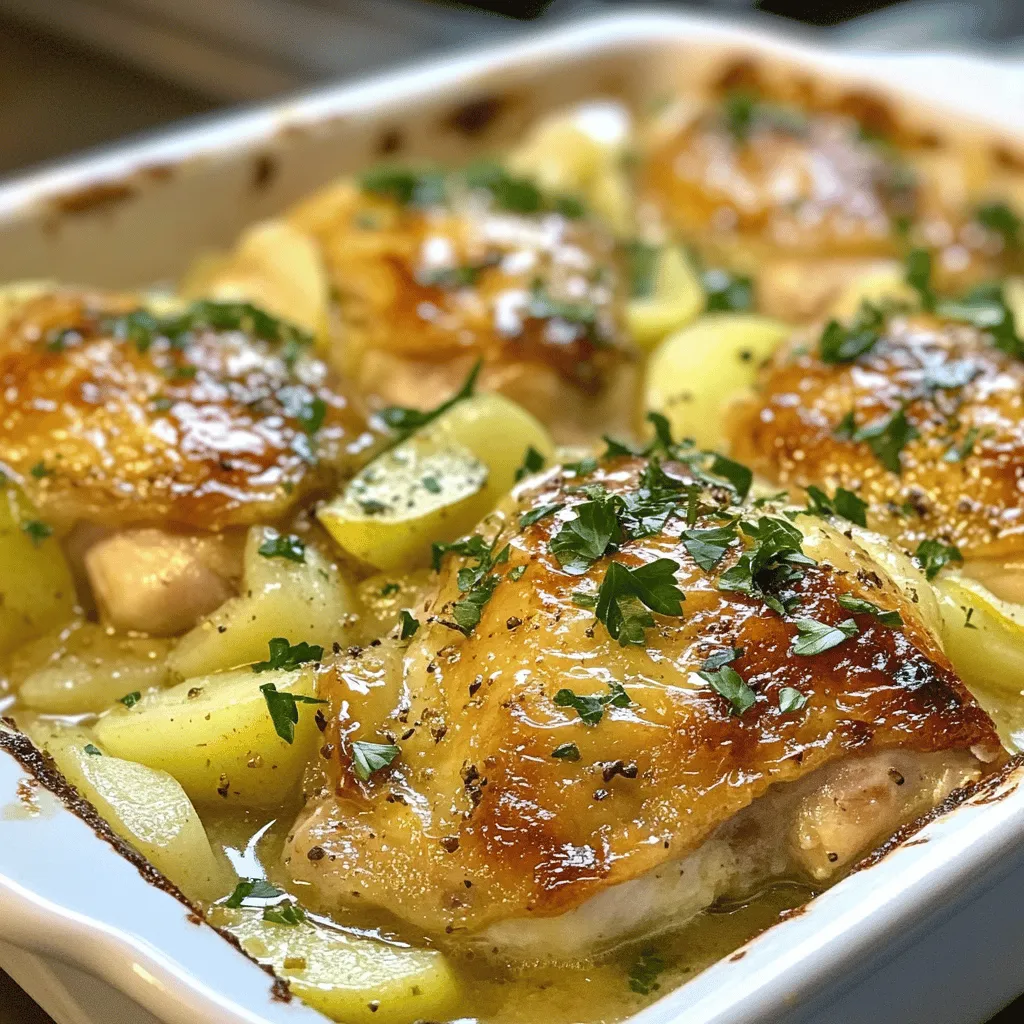Introduction
French cuisine is renowned for its regional specialties that reflect the diverse landscapes and cultural influences across the country. Each region boasts unique ingredients and cooking techniques, resulting in a rich tapestry of flavors and culinary traditions. One dish that stands out in this landscape is the French Chicken Casserole à la Normande. This delightful casserole showcases the essence of Normandy, a region celebrated for its lush pastures, fertile orchards, and coastal proximity, which contribute to its distinctive culinary offerings.
The French Chicken Casserole à la Normande is a comforting and hearty dish that combines tender chicken with the sweetness of apples, the richness of cream, and a medley of aromatic herbs. This casserole is not only a feast for the palate but also a celebration of seasonal ingredients, particularly the apples that are integral to Normande cooking. The balance of flavors in this dish makes it a beloved choice for family gatherings and cozy dinners, evoking the warmth of home-cooked meals.
The Origin of Casserole in French Cuisine
Casseroles hold a special place in French culinary tradition, with a history that dates back centuries. These one-pot meals have evolved from rustic farm cooking, where ingredients were combined and left to simmer slowly, allowing flavors to meld and develop. The concept of a casserole, characterized by its layered ingredients cooked in a single dish, aligns perfectly with the French philosophy of cooking—celebrating simplicity while highlighting the quality of ingredients.
Normandy, in particular, has significantly influenced the evolution of casserole dishes in France. Known for its abundant apple orchards, dairy farms, and seafood, Normandy’s culinary landscape is shaped by its geography. The region’s chefs have mastered the art of integrating local produce, like apples and cream, into their dishes, creating a unique flavor profile that defines Normande cuisine. The use of apples in savory dishes is a hallmark of this region, where the tartness of the fruit complements the richness of meat and dairy, resulting in a harmonious blend of flavors.
The significance of apples and cream in Normande cooking transcends mere taste; it reflects the agricultural heritage of the region. Normandy is one of France’s top apple-producing areas, and its famed cider is derived from these orchards. In this casserole, apples are not just a garnish; they play a crucial role in balancing the savory elements of the dish. Paired with crème fraîche—another Normande specialty—these ingredients create a sauce that is both creamy and tangy, enhancing the overall dining experience.
Ingredients Breakdown
To create the perfect French Chicken Casserole à la Normande, it’s essential to understand the role of each ingredient. Here’s a detailed breakdown:
Chicken Thighs
For this casserole, bone-in and skin-on chicken thighs are preferred. The bone adds flavor and moisture during cooking, while the skin crisps up beautifully, providing a delectable texture contrast to the tender meat. Chicken thighs are also more forgiving than breasts, as they remain juicy even when cooked for longer periods, making them ideal for a slow-cooked dish like this casserole.
Olive Oil and Butter
A combination of olive oil and butter is used to achieve the perfect sear on the chicken. Olive oil has a higher smoke point than butter, allowing for a nice browning without burning, while butter adds richness and depth of flavor. This blend of fats creates a flavorful base for the casserole, enhancing the overall taste of the dish.
Onions and Garlic
Aromatic ingredients such as onions and garlic form the foundation of this casserole. Onions are sautéed until soft and translucent, releasing their natural sweetness, while garlic adds an aromatic, pungent kick that elevates the entire dish. Together, they create a fragrant base that complements the other ingredients.
Apples
Choosing the right type of apples is crucial for achieving the desired flavor profile. Tart apples, such as Granny Smith or Braeburn, are ideal as they provide a refreshing contrast to the rich sauce. The apples soften during cooking, releasing their juices and infusing the dish with a natural sweetness that balances the savory elements.
Dry White Wine
Deglazing the pan with dry white wine is an essential step in the cooking process. The wine not only helps to lift the flavorful bits stuck to the bottom of the skillet but also adds depth and acidity to the sauce. A crisp, dry white wine complements the flavors of the chicken and apples, enhancing the overall taste of the casserole.
Chicken Broth and Crème Fraîche
Chicken broth is used as the cooking liquid, providing moisture and additional flavor to the casserole. It helps to create a rich, savory sauce as the ingredients simmer together. Crème fraîche is added later to create a creamy texture, enriching the dish while introducing a subtle tang that further balances the flavors.
Dijon Mustard, Thyme, Salt, and Pepper
Seasonings are pivotal in elevating the dish. Dijon mustard adds a sharp, tangy note, while fresh thyme contributes an earthy herbaceousness. Salt and pepper enhance the natural flavors of the ingredients, ensuring that each bite is well-seasoned and satisfying.
Fresh Parsley
Finally, fresh parsley is used as a finishing touch for flavor and presentation. A sprinkle of chopped parsley adds brightness and color, making the dish visually appealing while providing a fresh contrast to the rich, creamy casserole.
Step-by-Step Cooking Instructions
Now that we have explored the origins and ingredients of the French Chicken Casserole à la Normande, let’s dive into the cooking process. Follow these detailed instructions for preparing this delectable dish:
1. Preheat the Oven: Begin by preheating your oven to 350°F (175°C). This ensures that the casserole bakes evenly and reaches the desired temperature without delay.
2. Prepare the Skillet: In a large oven-safe skillet or Dutch oven, heat a tablespoon of olive oil and one tablespoon of butter over medium-high heat. Once the fats are hot, carefully add the chicken thighs, skin-side down, and sear them until golden brown—about 5-7 minutes. This step is crucial for developing flavor and texture.
3. Sear the Chicken: After the chicken has browned, flip the thighs to sear the other side for an additional 5 minutes. Once done, remove the chicken from the skillet and set it aside on a plate. This allows the chicken to rest while you build the flavor base for the casserole.
4. Sauté Aromatics: In the same skillet, add another tablespoon of olive oil if necessary, then toss in the chopped onions. Sauté the onions until they become soft and translucent, about 3-4 minutes. Next, add minced garlic and continue to sauté for an additional minute until fragrant.
5. Add Apples: Stir in the sliced tart apples and cook for about 5 minutes, allowing them to soften slightly. The apples will begin to release their juices, creating a natural sweetness that pairs beautifully with the savory elements of the dish.
6. Deglaze with Wine: Pour in the dry white wine, scraping the bottom of the skillet to release any browned bits. This step is essential for incorporating those flavors into the sauce. Allow the wine to simmer for a couple of minutes until it reduces slightly.
7. Combine Ingredients: Once the wine has reduced, return the seared chicken thighs to the skillet. Pour in the chicken broth, ensuring that the chicken is partially submerged. Add a tablespoon of Dijon mustard, a few sprigs of fresh thyme, and season with salt and pepper to taste.
8. Baking Time: Cover the skillet with a lid or aluminum foil and transfer it to the preheated oven. Bake for approximately 30-35 minutes, or until the chicken is cooked through and reaches an internal temperature of 165°F (74°C).
By following these steps, you will be well on your way to creating a delicious French Chicken Casserole à la Normande. As the casserole bakes, the aromas will fill your kitchen, inviting everyone to gather around the table for a warm and comforting meal. Stay tuned for the next segment, where we will explore additional cooking tips and serving suggestions to enhance your dining experience.

Techniques for Searing Chicken Thighs and Achieving a Golden Crust
Searing chicken thighs is a critical step in preparing the French Chicken Casserole à la Normande, as it creates a rich layer of flavor and a beautiful golden crust. To achieve this, begin by patting the chicken thighs dry with paper towels; moisture on the surface can hinder browning. Season the thighs generously with salt and black pepper. Next, heat a large, heavy skillet over medium-high heat and add a couple of tablespoons of olive oil. Once the oil is shimmering, carefully place the chicken thighs skin-side down in the skillet.
Do not overcrowd the pan; this will lower the temperature and result in steaming rather than searing. Allow the chicken to cook undisturbed for about 5-7 minutes until the skin is a deep golden brown. It’s essential to resist the urge to move the chicken around while it cooks. After achieving the desired color, flip the thighs and cook for an additional 3-4 minutes. This technique not only locks in juices but also builds a foundation of flavor for the casserole.
Cooking the Onions and Garlic to Build Flavor
Once the chicken thighs are seared, remove them from the skillet and set them aside on a plate. In the same pan, retain the drippings, as they are packed with flavor. Lower the heat to medium and add sliced onions, cooking until they become translucent and begin to caramelize. This should take about 5-7 minutes. The sweetness of the onions will complement the savory notes of the chicken wonderfully.
Next, add minced garlic and sauté for an additional minute, just until fragrant. Be cautious not to burn the garlic, as it can turn bitter quickly. This combination of onions and garlic forms the aromatic base that elevates the dish, enhancing the overall flavor profile of your casserole.
Incorporating Apples and Their Cooking Tips for Optimal Results
Incorporating apples into this dish is a hallmark of the Normande style, providing a subtle sweetness that balances the richness of the chicken and sauce. Choose firm apples such as Granny Smith or Honeycrisp, as they retain their shape well during cooking. Core and slice the apples into wedges, then add them to the skillet after the onions and garlic have softened.
Sauté the apples for about 3-4 minutes, allowing them to caramelize slightly. This step not only adds flavor but also creates a lovely texture contrast against the tender chicken and creamy sauce. If desired, a sprinkle of cinnamon can be added at this stage to enhance the apple flavor further.
Deglazing with Wine and the Significance of This Step
With the onions, garlic, and apples now softened, it’s time to deglaze the pan. Pour in a generous splash of dry white wine, scraping the bottom of the skillet with a wooden spoon to release all those flavorful browned bits. This step is essential as it infuses the dish with acidity, balancing the richness of the chicken and cream. A dry white wine, such as Sauvignon Blanc or Chardonnay, works beautifully here. Allow the wine to simmer for a few minutes, letting it reduce by half. The resulting mixture will be a flavorful base for your casserole.
Combining the Sauce Ingredients and Their Role in the Final Dish
Next, it’s time to create the luscious sauce that will envelop the chicken. Add chicken broth to the skillet along with heavy cream, stirring to combine. This mixture will form the rich, velvety sauce that is characteristic of a classic casserole. For added depth, incorporate a tablespoon of Dijon mustard and a few fresh thyme sprigs. The mustard adds a tangy complexity, while the thyme infuses the dish with a fragrant herbaceous note. Bring the sauce to a gentle simmer, allowing it to thicken slightly before nestling the chicken back into the skillet.
Nestling Chicken in the Sauce and Preparing for Baking
Once the sauce is ready, return the seared chicken thighs to the skillet, skin-side up. Ensure they are submerged in the sauce, allowing the flavors to meld during baking. If you have fresh parsley or additional thyme, sprinkle some over the chicken for added color before transferring the skillet to the oven. If your skillet is not oven-safe, carefully transfer the chicken and sauce to a baking dish, ensuring an even layer of sauce covers the chicken.
Baking Instructions, Including Optimal Cooking Times and Temperatures
Preheat your oven to 375°F (190°C). Place the casserole in the preheated oven and bake for about 30-40 minutes, or until the chicken is cooked through and reaches an internal temperature of 165°F (74°C). The skin should be golden and crispy, while the sauce thickens and bubbles around the edges. For an extra crispy skin, you can broil the casserole for the last 2-3 minutes of cooking, but keep a close eye to prevent burning.
Importance of Resting the Dish Before Serving
Once out of the oven, it’s crucial to let the casserole rest for about 10 minutes before serving. This resting period allows the juices to redistribute throughout the chicken, ensuring moist and flavorful portions. As the dish cools slightly, the sauce will continue to thicken, creating a perfect consistency for spooning over the chicken when plating.
Serving Suggestions
When it comes to serving French Chicken Casserole à la Normande, consider complementary side dishes that enhance the rustic charm of this dish. Here are some ideas:
– Side Dishes: A simple green salad dressed lightly with a vinaigrette will provide a refreshing contrast to the richness of the casserole. Roasted vegetables, such as carrots and Brussels sprouts, can also add color and texture to your meal. For a heartier option, creamy mashed potatoes or buttery egg noodles will soak up the delicious sauce beautifully.
– Bread: Crusty French bread or a baguette is ideal for mopping up the sauce. A slice of rustic country bread can also add a delightful crunch alongside the soft textures of the casserole.
– Wine Pairings: To enhance your dining experience, pair the casserole with a glass of dry white wine, such as a crisp Sauvignon Blanc or a lightly oaked Chardonnay. These wines complement the creamy sauce and add a refreshing note to the meal.
– Presentation Tips: When serving, use a large spoon to carefully place a chicken thigh onto each plate, ensuring a generous portion of sauce accompanies it. For an elegant touch, garnish with freshly chopped parsley or thyme. A sprinkle of freshly cracked black pepper can also add a pop of flavor and visual appeal.
Nutritional Information
Understanding the nutritional value of your meal can help in maintaining a balanced diet while enjoying comfort food. Here’s an overview of the nutritional breakdown for a serving of French Chicken Casserole à la Normande:
– Calories: Approximately 450-500 calories per serving, depending on the portion size and specific ingredients used.
– Protein: Each serving contains around 30-35 grams of protein, thanks to the chicken thighs, making it a filling and satisfying dish.
– Fats: The casserole includes about 25 grams of fat, primarily from the chicken skin and cream, which contributes to the rich flavor and creamy texture.
– Carbohydrates: With an estimated 20-25 grams of carbohydrates per serving, the dish is relatively moderate in carbs, especially when paired with low-carb sides.
Using wholesome ingredients, like fresh apples and herbs, not only enhances the flavor but also adds nutritional benefits. The dish offers a balance of indulgence and health, making it suitable for both everyday meals and special occasions.
Conclusion
French Chicken Casserole à la Normande is a delightful dish that brings the warmth and comfort of homemade cooking to your table. With its rich flavors, tender chicken, and creamy apple-infused sauce, it’s a true celebration of the culinary traditions of Normandy. Whether you’re preparing a weeknight dinner or hosting a special gathering, this casserole is sure to impress your family and friends.
The rustic charm of casseroles makes them perfect for sharing, evoking feelings of comfort and nostalgia. As you explore the flavors of Normandy in your own kitchen, we encourage you to try making this exquisite dish. Not only will you enjoy the delightful taste, but you will also create lasting memories around the dinner table. Bon appétit!


